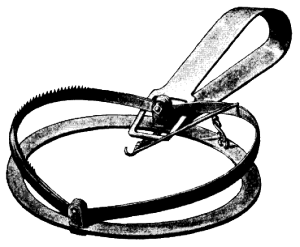
Source: Wikipedia
Paul S. asked (private circle share) about 5E rules for setting traps. Some traps, like setting a bucket of paint on a door that is ajar or scattering marbles, do not require any special rules. You set them, and they trigger if situationally appropriate. They can be handled entirely by description and ruling. Setting more sophisticated traps, such as a concealed snare, present an opportunity for leveraging existing mechanics to support character abilities that are not explicitly handled.
5E already has rules for crafting using tool proficiencies. Thus, setting a trap requires trap-maker’s tools, which can be improvised. Simple traps can be set in one dungeon turn, but more complex devices may require more time. If the crafting is possible but uncertain in some way (such as under time pressure), require a crafting check (probably DC 10, but adjust as necessary).
A set of trap-maker’s tools is a small kit containing cords, wires, springs, and so forth that functions similarly to a healer’s kit. It counts as one significant item (if using simple encumbrance), and is exhausted using whatever rules are in effect for healer’s kits (in the 5E PHB, this is 10 uses, but I might use an ammo die).
Tools can be improvised from local detritus, standard, or masterwork. The referee must rule whether tools can be improvised in a given situation. If tools are improvised, saving throws versus trap effects are made with advantage. If masterwork, they are made with disadvantage.
Trap DC works like spell DC: 8 + ability bonus + proficiency bonus.
Crude mechanical traps (such as rigging a swinging log) use dexterity. More sophisticated traps based on specialized knowledge (such as crafting a poison needle mechanism) use intelligence.
Example 1: first level character without proficiency, using improvised tools, with dexterity of 12 (+1). Trap DC is 9 (8+1), victims make saves with advantage (due to improvised tools).
Example 2: first level character with proficiency (+2), with dexterity of 15 (+2), using standard trap-maker’s tools. Trap DC is 12 (8+2+2), saves are unmodified (since standard tools were used).
